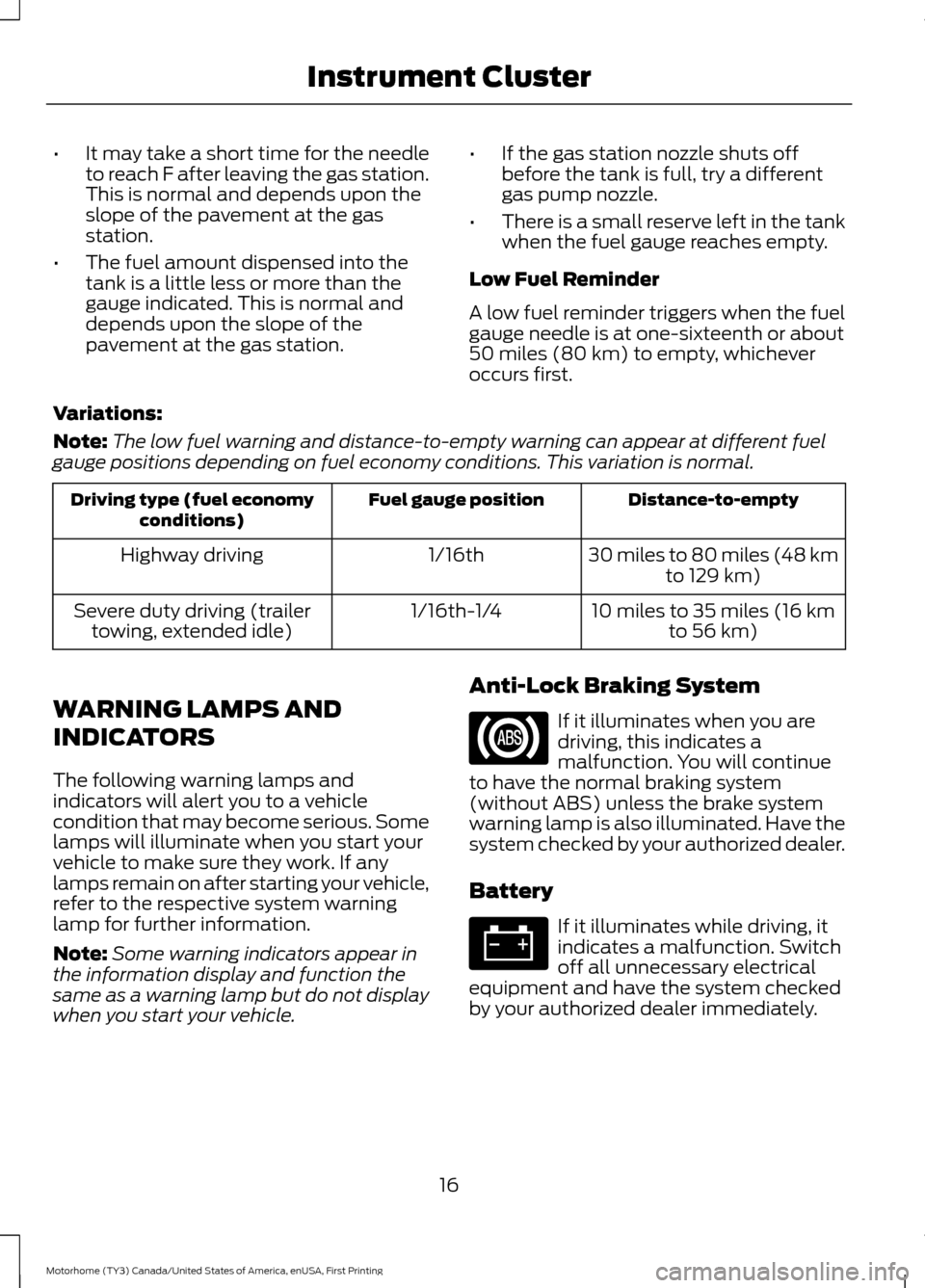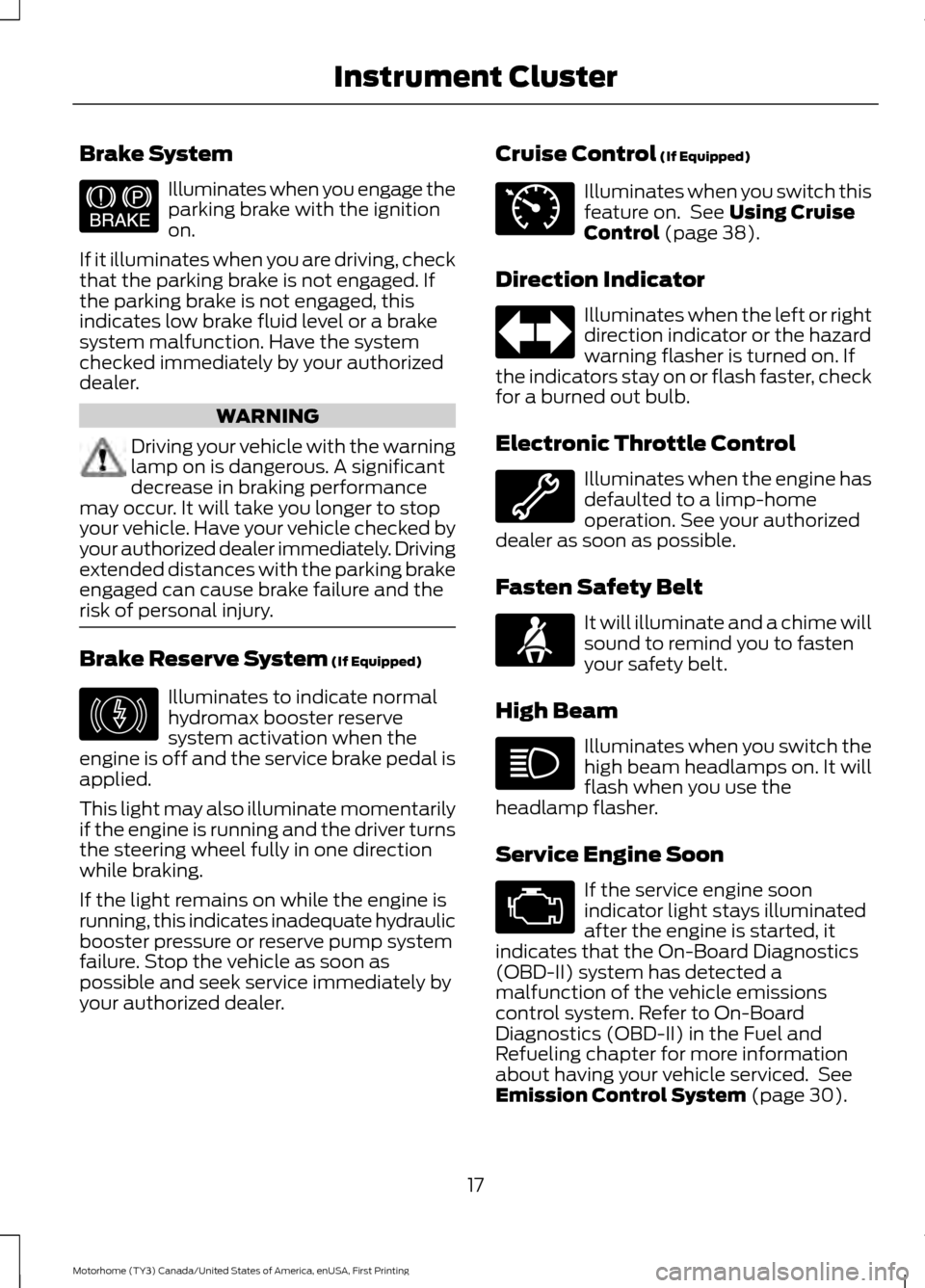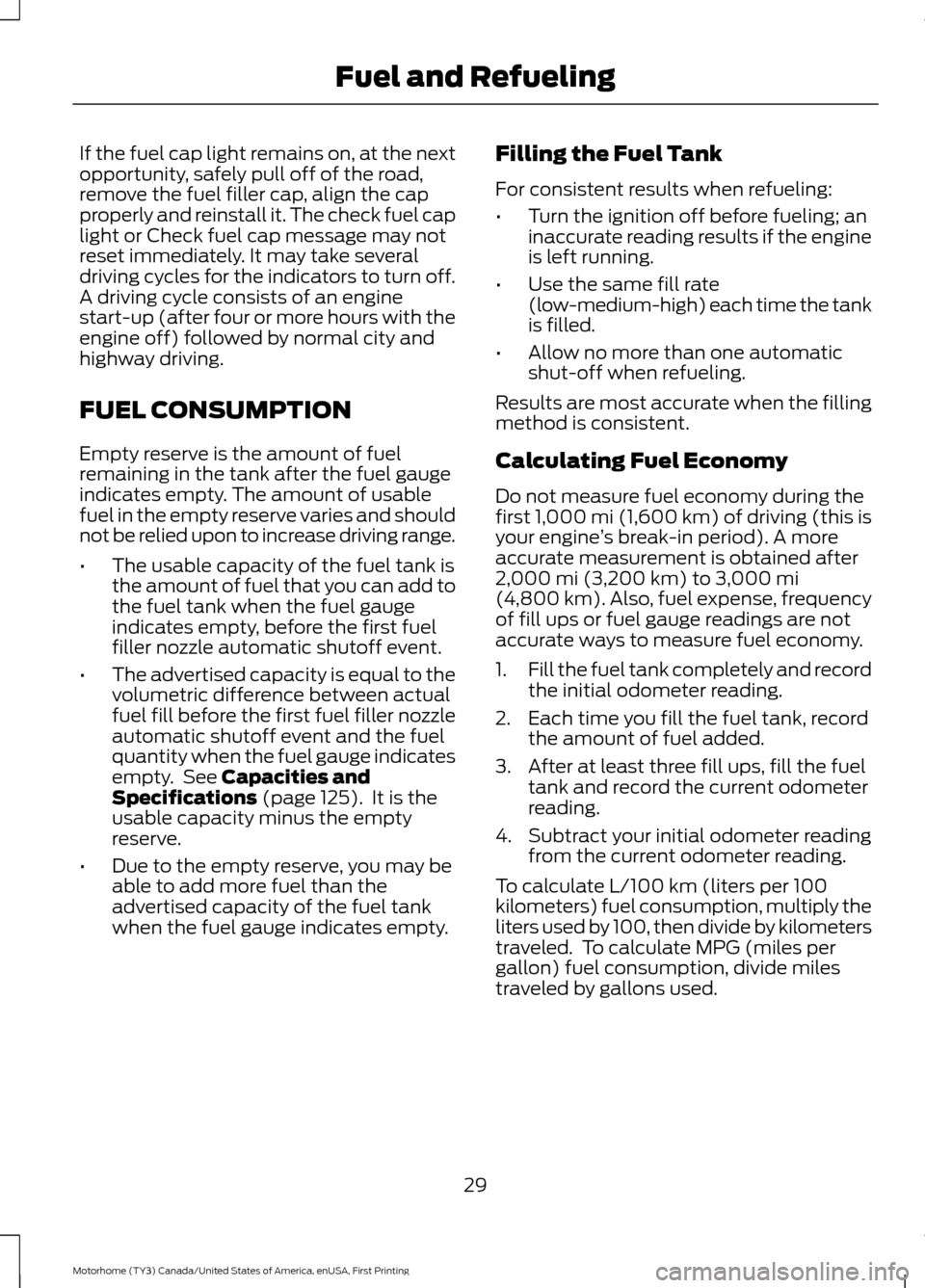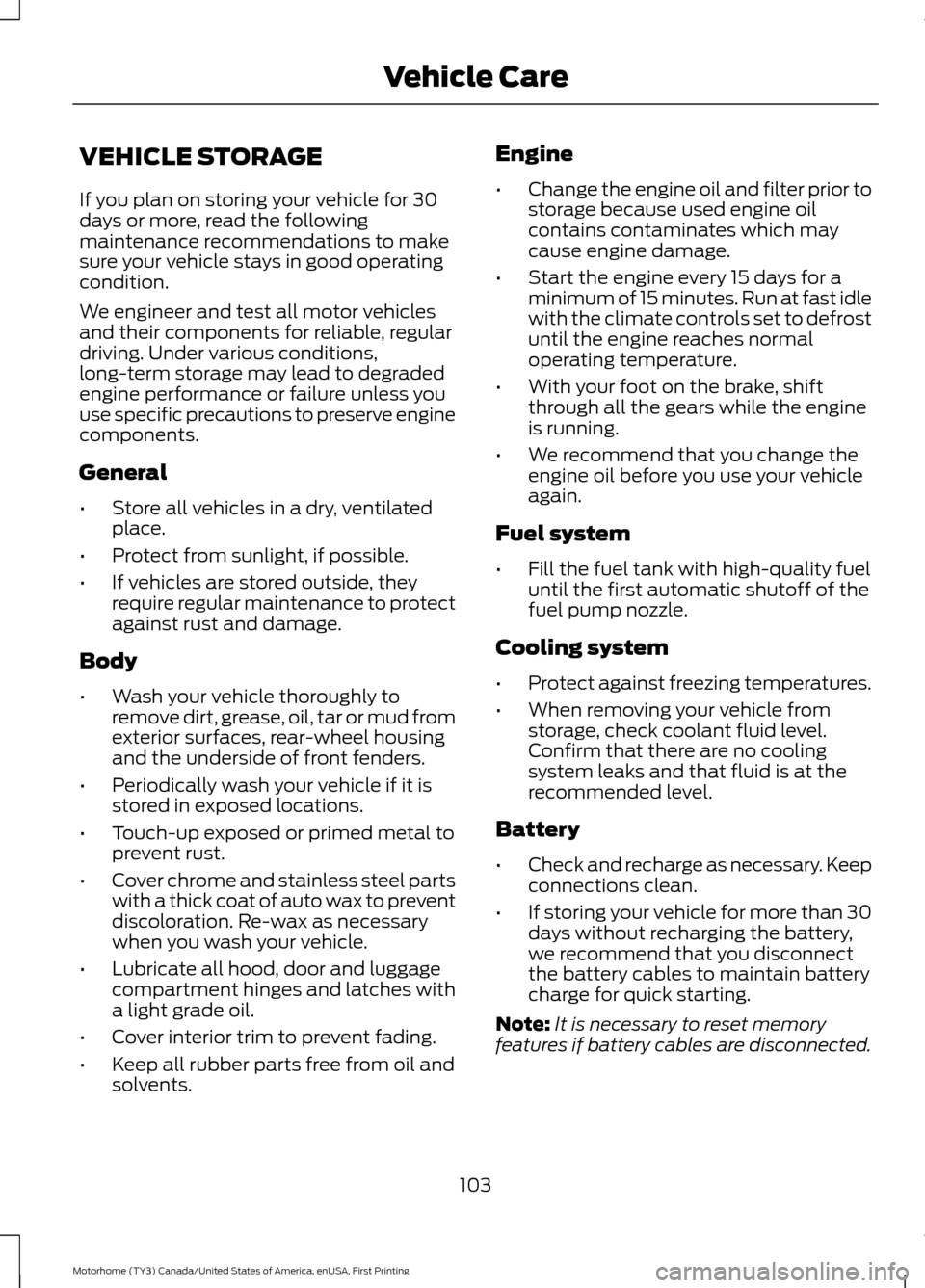2017 FORD F SERIES MOTORHOME AND COMMERCIAL CHASSIS fuel reserve
[x] Cancel search: fuel reservePage 19 of 164

•
It may take a short time for the needle
to reach F after leaving the gas station.
This is normal and depends upon the
slope of the pavement at the gas
station.
• The fuel amount dispensed into the
tank is a little less or more than the
gauge indicated. This is normal and
depends upon the slope of the
pavement at the gas station. •
If the gas station nozzle shuts off
before the tank is full, try a different
gas pump nozzle.
• There is a small reserve left in the tank
when the fuel gauge reaches empty.
Low Fuel Reminder
A low fuel reminder triggers when the fuel
gauge needle is at one-sixteenth or about
50 miles (80 km) to empty, whichever
occurs first.
Variations:
Note: The low fuel warning and distance-to-empty warning can appear at different fuel
gauge positions depending on fuel economy conditions. This variation is normal. Distance-to-empty
Fuel gauge position
Driving type (fuel economy
conditions)
30 miles to 80 miles (48 kmto 129 km)
1/16th
Highway driving
10 miles to 35 miles (16 kmto 56 km)
1/16th-1/4
Severe duty driving (trailer
towing, extended idle)
WARNING LAMPS AND
INDICATORS
The following warning lamps and
indicators will alert you to a vehicle
condition that may become serious. Some
lamps will illuminate when you start your
vehicle to make sure they work. If any
lamps remain on after starting your vehicle,
refer to the respective system warning
lamp for further information.
Note: Some warning indicators appear in
the information display and function the
same as a warning lamp but do not display
when you start your vehicle. Anti-Lock Braking System If it illuminates when you are
driving, this indicates a
malfunction. You will continue
to have the normal braking system
(without ABS) unless the brake system
warning lamp is also illuminated. Have the
system checked by your authorized dealer.
Battery If it illuminates while driving, it
indicates a malfunction. Switch
off all unnecessary electrical
equipment and have the system checked
by your authorized dealer immediately.
16
Motorhome (TY3) Canada/United States of America, enUSA, First Printing Instrument Cluster
Page 20 of 164

Brake System
Illuminates when you engage the
parking brake with the ignition
on.
If it illuminates when you are driving, check
that the parking brake is not engaged. If
the parking brake is not engaged, this
indicates low brake fluid level or a brake
system malfunction. Have the system
checked immediately by your authorized
dealer. WARNING
Driving your vehicle with the warning
lamp on is dangerous. A significant
decrease in braking performance
may occur. It will take you longer to stop
your vehicle. Have your vehicle checked by
your authorized dealer immediately. Driving
extended distances with the parking brake
engaged can cause brake failure and the
risk of personal injury. Brake Reserve System (If Equipped)
Illuminates to indicate normal
hydromax booster reserve
system activation when the
engine is off and the service brake pedal is
applied.
This light may also illuminate momentarily
if the engine is running and the driver turns
the steering wheel fully in one direction
while braking.
If the light remains on while the engine is
running, this indicates inadequate hydraulic
booster pressure or reserve pump system
failure. Stop the vehicle as soon as
possible and seek service immediately by
your authorized dealer. Cruise Control
(If Equipped) Illuminates when you switch this
feature on. See
Using Cruise
Control (page 38).
Direction Indicator Illuminates when the left or right
direction indicator or the hazard
warning flasher is turned on. If
the indicators stay on or flash faster, check
for a burned out bulb.
Electronic Throttle Control Illuminates when the engine has
defaulted to a limp-home
operation. See your authorized
dealer as soon as possible.
Fasten Safety Belt It will illuminate and a chime will
sound to remind you to fasten
your safety belt.
High Beam Illuminates when you switch the
high beam headlamps on. It will
flash when you use the
headlamp flasher.
Service Engine Soon If the service engine soon
indicator light stays illuminated
after the engine is started, it
indicates that the On-Board Diagnostics
(OBD-II) system has detected a
malfunction of the vehicle emissions
control system. Refer to On-Board
Diagnostics (OBD-II) in the Fuel and
Refueling chapter for more information
about having your vehicle serviced. See
Emission Control System
(page 30).
17
Motorhome (TY3) Canada/United States of America, enUSA, First Printing Instrument ClusterE144522 E146190 E71340
Page 32 of 164

If the fuel cap light remains on, at the next
opportunity, safely pull off of the road,
remove the fuel filler cap, align the cap
properly and reinstall it. The check fuel cap
light or Check fuel cap message may not
reset immediately. It may take several
driving cycles for the indicators to turn off.
A driving cycle consists of an engine
start-up (after four or more hours with the
engine off) followed by normal city and
highway driving.
FUEL CONSUMPTION
Empty reserve is the amount of fuel
remaining in the tank after the fuel gauge
indicates empty. The amount of usable
fuel in the empty reserve varies and should
not be relied upon to increase driving range.
•
The usable capacity of the fuel tank is
the amount of fuel that you can add to
the fuel tank when the fuel gauge
indicates empty, before the first fuel
filler nozzle automatic shutoff event.
• The advertised capacity is equal to the
volumetric difference between actual
fuel fill before the first fuel filler nozzle
automatic shutoff event and the fuel
quantity when the fuel gauge indicates
empty. See Capacities and
Specifications (page 125). It is the
usable capacity minus the empty
reserve.
• Due to the empty reserve, you may be
able to add more fuel than the
advertised capacity of the fuel tank
when the fuel gauge indicates empty. Filling the Fuel Tank
For consistent results when refueling:
•
Turn the ignition off before fueling; an
inaccurate reading results if the engine
is left running.
• Use the same fill rate
(low-medium-high) each time the tank
is filled.
• Allow no more than one automatic
shut-off when refueling.
Results are most accurate when the filling
method is consistent.
Calculating Fuel Economy
Do not measure fuel economy during the
first
1,000 mi (1,600 km) of driving (this is
your engine ’s break-in period). A more
accurate measurement is obtained after
2,000 mi (3,200 km)
to 3,000 mi
(4,800 km). Also, fuel expense, frequency
of fill ups or fuel gauge readings are not
accurate ways to measure fuel economy.
1. Fill the fuel tank completely and record
the initial odometer reading.
2. Each time you fill the fuel tank, record the amount of fuel added.
3. After at least three fill ups, fill the fuel tank and record the current odometer
reading.
4. Subtract your initial odometer reading from the current odometer reading.
To calculate L/100 km (liters per 100
kilometers) fuel consumption, multiply the
liters used by 100, then divide by kilometers
traveled. To calculate MPG (miles per
gallon) fuel consumption, divide miles
traveled by gallons used.
29
Motorhome (TY3) Canada/United States of America, enUSA, First Printing Fuel and Refueling
Page 106 of 164

VEHICLE STORAGE
If you plan on storing your vehicle for 30
days or more, read the following
maintenance recommendations to make
sure your vehicle stays in good operating
condition.
We engineer and test all motor vehicles
and their components for reliable, regular
driving. Under various conditions,
long-term storage may lead to degraded
engine performance or failure unless you
use specific precautions to preserve engine
components.
General
•
Store all vehicles in a dry, ventilated
place.
• Protect from sunlight, if possible.
• If vehicles are stored outside, they
require regular maintenance to protect
against rust and damage.
Body
• Wash your vehicle thoroughly to
remove dirt, grease, oil, tar or mud from
exterior surfaces, rear-wheel housing
and the underside of front fenders.
• Periodically wash your vehicle if it is
stored in exposed locations.
• Touch-up exposed or primed metal to
prevent rust.
• Cover chrome and stainless steel parts
with a thick coat of auto wax to prevent
discoloration. Re-wax as necessary
when you wash your vehicle.
• Lubricate all hood, door and luggage
compartment hinges and latches with
a light grade oil.
• Cover interior trim to prevent fading.
• Keep all rubber parts free from oil and
solvents. Engine
•
Change the engine oil and filter prior to
storage because used engine oil
contains contaminates which may
cause engine damage.
• Start the engine every 15 days for a
minimum of 15 minutes. Run at fast idle
with the climate controls set to defrost
until the engine reaches normal
operating temperature.
• With your foot on the brake, shift
through all the gears while the engine
is running.
• We recommend that you change the
engine oil before you use your vehicle
again.
Fuel system
• Fill the fuel tank with high-quality fuel
until the first automatic shutoff of the
fuel pump nozzle.
Cooling system
• Protect against freezing temperatures.
• When removing your vehicle from
storage, check coolant fluid level.
Confirm that there are no cooling
system leaks and that fluid is at the
recommended level.
Battery
• Check and recharge as necessary. Keep
connections clean.
• If storing your vehicle for more than 30
days without recharging the battery,
we recommend that you disconnect
the battery cables to maintain battery
charge for quick starting.
Note: It is necessary to reset memory
features if battery cables are disconnected.
103
Motorhome (TY3) Canada/United States of America, enUSA, First Printing Vehicle Care
Page 163 of 164

Speed Control
See: Cruise Control.............................................. 38
Starter Switch See: Ignition Switch............................................. 23
Starting a Gasoline Engine.........................23 Failure to Start....................................................... 24
Guarding Against Exhaust Fumes.................24
Important Ventilating Information................24
Stopping the Engine When Your Vehicle is Moving................................................................. 24
Stopping the Engine When Your Vehicle is Stationary........................................................... 24
Starting and Stopping the Engine............23 General Information............................................ 23
Steering Wheel................................................10
Symbols Glossary.............................................3
T
Technical Specifications See: Capacities and Specifications.............125
The Better Business Bureau (BBB) Auto Line Program (U.S. Only).........................60
Tire Care
...........................................................105
Glossary of Tire Terminology......................... 106
Information About Uniform Tire Quality Grading.............................................................. 105
Information Contained on the Tire Sidewall............................................................. 107
Temperature A B C............................................ 106
Traction AA A B C............................................... 105
Treadwear............................................................. 105
Tires See: Wheels and Tires...................................... 105
Towing a Trailer...............................................45 Load Placement................................................... 45
Towing the Vehicle on Four Wheels.......50 Emergency Towing.............................................. 50
Towing................................................................45
Transmission Code Designation.............128
Transmission....................................................33
Transmission See: Transmission................................................ 33
Transporting the Vehicle
.............................56
Type Approvals.............................................154
RF Certification Logos for Tire Pressure
Monitoring Sensor(s)................................... 154U
Under Hood Overview - Commercial
Chassis............................................................86
Under Hood Overview - Motorhome Chassis............................................................87
Using Cruise Control.....................................38 Switching Cruise Control Off........................... 38
Switching Cruise Control On............................ 38
Using Snow Chains
......................................120
Utilizing the Mediation/Arbitration Program (Canada Only)............................61
V
Vehicle Care.....................................................101 General Information........................................... 101
Vehicle Certification Label.........................127
Vehicle Identification Number
.................127
Vehicle Storage.............................................103 Battery.................................................................... 103
Body........................................................................\
103
Brakes..................................................................... 104
Cooling system.................................................... 103
Engine..................................................................... 103
Fuel system.......................................................... 103
General................................................................... 103
Miscellaneous...................................................... 104
Removing Vehicle From Storage.................. 104
Tires........................................................................\
. 104
VIN See: Vehicle Identification Number..............127
W
Warning Lamps and Indicators..................16 Anti-Lock Braking System................................. 16
Battery....................................................................... 16
Brake Reserve System......................................... 17
Brake System.......................................................... 17
Cruise Control.......................................................... 17
Direction Indicator................................................. 17
Electronic Throttle Control................................. 17
Fasten Safety Belt................................................. 17
High Beam................................................................ 17
Service Engine Soon............................................. 17
Transmission Tow/Haul...................................... 18
160
Motorhome (TY3) Canada/United States of America, enUSA, First Printing Index